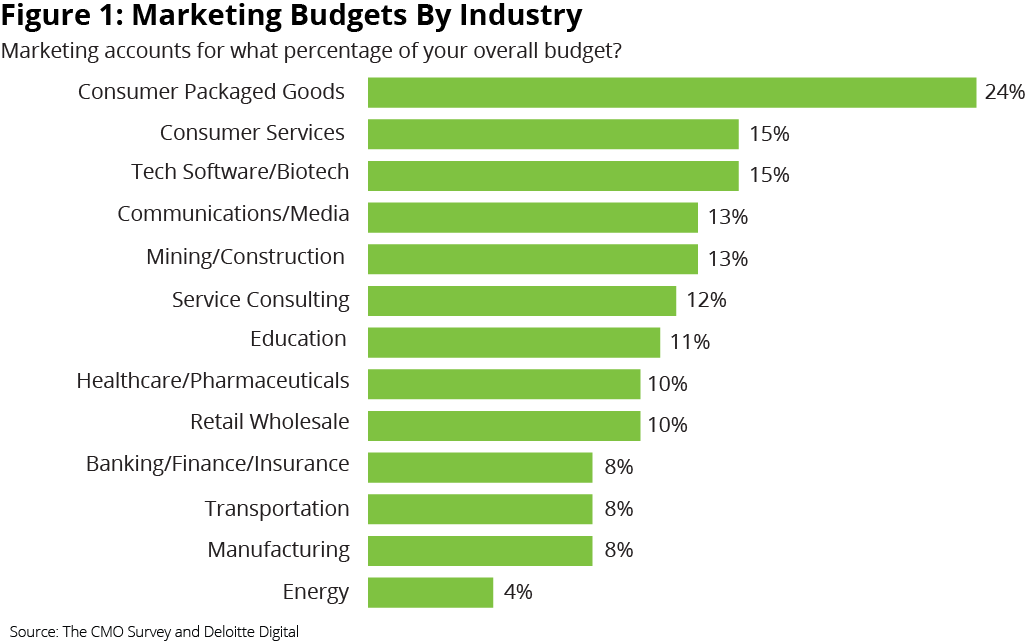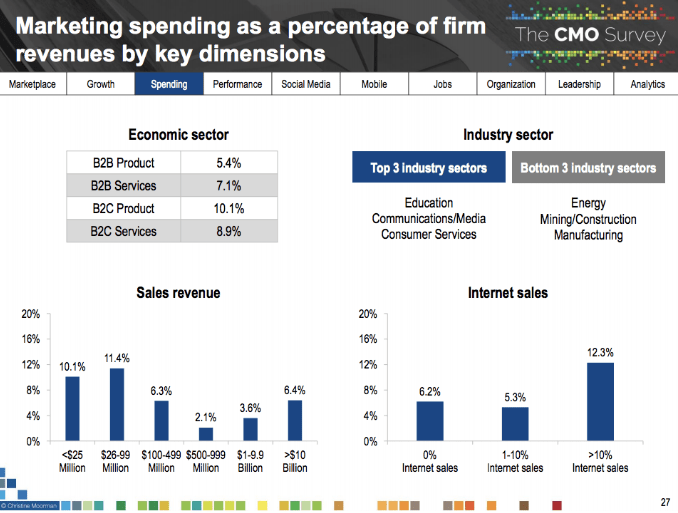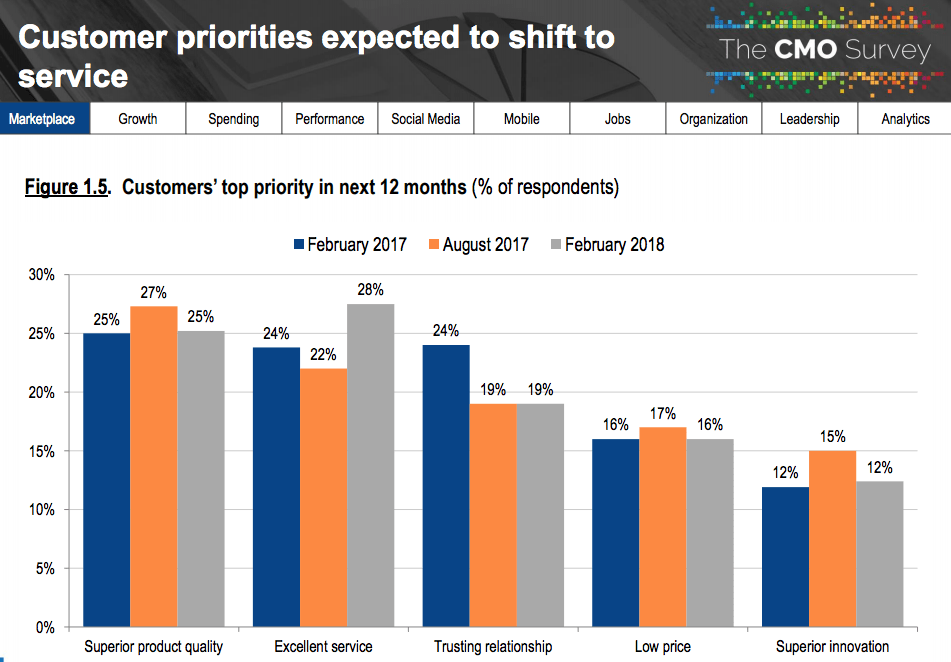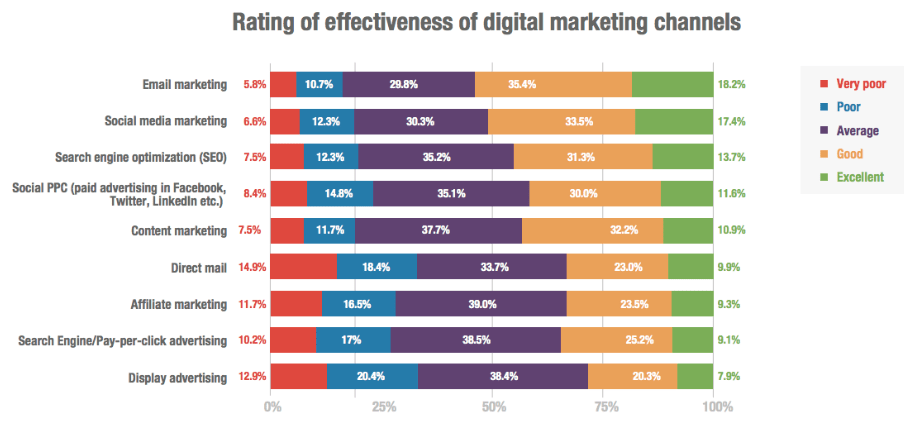It’s that time of year to finalize your marketing budget. In the budget process, management needs to view marketing and sales as an investment, not an expense. As such, investments are predicated on their returns. Traditionally, advertising programs have been straight forward, but difficult to quantify. Gone are the days of just attending trade shows, buying ads and doing some PR. Companies are now spending half of their marketing dollars on digital efforts, using a variety of marketing tools and customer service applications. Marketing is rapidly moving to digital which is easy to measure, but due to the numerous options difficult to plan. The best way to determine how much to spend, where to spend it and what to expect is to evaluate other companies in your vertical.
We find CMO Survey a valuable resource of where companies like yours are spending their dollars and what they are achieving from it. The Annual CMO Survey Highlights and Insights Report provides data that can help your organization plan for 2019.
Marketing Budget by Industry, Type and Size
A popular question around this time every year is ‘How much should I budget for marketing next year?’ Most companies plan on allocating a percentage of their annual sales to marketing efforts each year. This percentage can vary based on company size, industry, and target market.
Half of the companies surveyed in the CMO Survey include salary and associated expenses in their marketing budgets, while the other half just reported expenses. Most companies set their budget at 10% to 12% of sales, including salaries, with a focus on digital marketing, analytics, customer experience, and ecommerce.
According to the CMO Survey industries such as consumer goods spend up to 24%, while manufacturing spends just 8%. Source: Wall Street Journal.

CMO Survey also provides a breakdown by type of business relative to size. For example, a B2B product company averages 5.4% of sales, while a B2C product companies spends almost double at 10.1%. Depending on your size, a $50 million company spends 11.4% on average, while a $500 million spends 2.1%. Using relative ratios you can figure out exactly how much similar companies are spending.

How you allocate the budget once it is set can also be determined by what works best for your industry, but also what kind Return On Investment (ROI) you are hoping to achieve. Some of the more effective marketing methods and efforts are website, advertising, events, social media, and public relations. Email marketing is making a resurgence and receiving very good results with higher ROIs.
Return on Investment (ROI)
How do you know how much to spend on content marketing, SEO, paid search, display advertising, and other high priority digital marketing activities? It’s important to measure ROI for all marketing activities in order to prioritize investments.
ROI is the gain from the investment minus the cost of the investment divided by the cost of the investment ratio of resulting sales divided by marketing expenses of the activity ROI = (gain-cost)/cost.
When calculating total cost, make sure to include all expenses including labor, materials, and advertising efforts. Gains may be profits of a sale or the long term value of a customer depending your business model. ROI calculations can be complex as Harvard University has outlined.
Studies have indicated that, as a whole, email typically produces the highest ROI followed by SEO and paid search. A good ROI benchmark is $5 with $10 being exceptional. Qlutch Marketing has some great calculators to help you figure out your ROI.
Technology
Your marketing efforts should not be solely focused on attracting new customers, but should also focus on retaining and engaging with your current customer base. CMO Survey results also show that excellent customer service and superior product quality have become more important to customers than relationship or price. Web technology such as customer support, sales force automation and email marketing platforms are becoming a must in serving your customer base. With so many different technologies and infrastructure companies need a way to bring it all together for the optimal customer experience.
As a result, we see companies allocating their budgets to create Customer Engagement Portals that bring these technologies together and establishing virtual relationships with their customers. With security being a top concern, customers want to log into a protected, self-serve environment where they can order products, access a knowledge base, create support tickets, download software upgrades, and communicate with other like-minded customers. These portals provide private, secure and integrated access to these automation tools. CommonPlaces has delivered hundreds of these portals and our clients see an increase in customer retention and satisfaction, with great ROI.

Digital Marketing
Most companies are now spending up to 45% on digital marketing activities and about 20% on organic and paid search. Online video will represent the highest growth category for spend, with anticipated investment doubling over the next five years. The advertising world is also changing with traditional media, trade shows and catalogs are losing effectiveness. That’s why most companies are increasing their budgets in digital and moving away from traditional media.

Every company and industry is different, so you need to determine what is best for your company and then allocate those funds based on your desired ROI. Since digital marketing is providing better ROI than traditional media, companies are investing upwards of half of their marketing budget on digital. Digital technology is allowing reach worldwide more than ever before.
Reducing churn and taking care of your customers is becoming more important than ever. Acquiring new customers is expensive and the competition has the budget to lure your customers away. When you create your 2019 marketing budget make sure you include the technology required to engage existing customers and attract new ones.
Staying current on what is important to your customers and what keeps them loyal should drive all budget decision factors.
We’d love to hear from you. Where are you planning on spending your marketing budget in 2019? How is this different from your 2018 budget and why?
Let us know. Good luck, these are exciting times.



